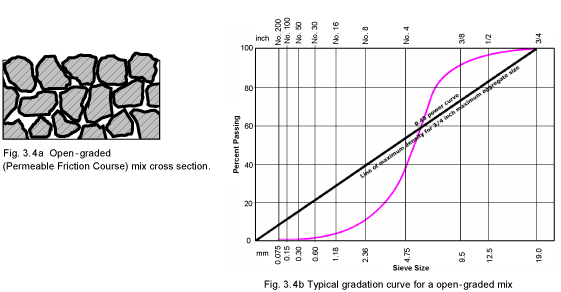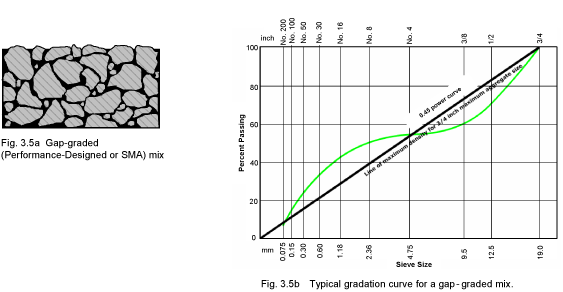6.1 General
Hot-mix asphalt (HMA) is a generic term that includes many different types of mixtures of aggregate and asphalt cement (binder) produced at elevated temperatures (generally between 300-350ºF) in an asphalt plant. Typically, HMA mixtures are divided into three mixture categories: dense-graded; open-graded; and gap-graded as a function of the aggregate gradation used in the mix.
A variation on traditional hot-mix asphalt is warm-mix asphalt (WMA). WMA technologies are processes or additives to HMA that allow mixture production and placement to occur at temperatures (30-100ºF) lower than conventional HMA without sacrificing performance. Technology currently used to make the WMA process possible are chemical or organic binder additives, chemical mixture additives, foaming admixtures, and binder foaming using water-based plant modifications.
Additives and processes pre-qualified for use on department projects can be found on the approved
.
Significant benefits derived from using WMA include:
- reduced fuel requirements for mixture production,
- extended time available for compaction/workability, particularly for mixtures containing polymer-modified asphalt binders and thin lift/cool weather applications,
- increased haul distance,
- improved workability of harsher mixtures including those incorporating reclaimed asphalt pavement (RAP) and recycled asphalt shingles (RAS), and
- potential lower oxidation/improved fatigue life.
The following information addresses HMA mixtures, but generally does not differ appreciably from WMA. Typically, the same parent test procedures or specification item applies to both types of asphalt mixtures.
Dense-graded
mixes are produced with well or continuously graded aggregate (gradation curve does not have any abrupt slope change) and are specified under the current Items 340 (Small Quantity) and 341. Typically, larger aggregates “float” in a matrix of mastic composed of asphalt cement and screenings/fines (see Figure 3-3).Open-graded
mixes are produced with relatively uniform-sized aggregate typified by an absence of intermediate-sized particles and low proportion of fines particles (gradation curve has a nearly vertical drop in intermediate size range). Mixes typical of this structure are the permeable friction course (Item 342) and asphalt-treated permeable bases. Because of their open structure, precautions are taken to minimize asphalt drain-down by using modified binders (A-R) “asphalt rubber,” or by use of fibers. Stone-on-stone contact with a heavy asphalt cement particle coating typifies these mixes (see Figure 3-4).Gap-graded
mixes use an aggregate gradation with particles ranging from coarse to fine with some intermediate sizes missing or present in small amounts. The gradation curve may have a “flat” region denoting the absence of a particle size or a steep slope denoting small quantities of these intermediate aggregate sizes (see Figure 3-5). These mixes are also typified by stone-on-stone contact and can be more permeable than dense-graded mixes (Item 344, Superpave Mixtures), or highly impermeable (Item 346, Stone-Matrix Asphalt).Stone-matrix asphalt (SMA) will be missing most intermediate sizes but have a relatively high proportion of fines. Fibers or modified binders (A-R) are combined with these fines to build a rich mastic coating around and between large aggregate particles. Compacting and hand-working these mixes are usually more difficult than with either dense-graded or open-graded mixes.

Figure 3-3. Dense-graded mix cross-section and typical gradation curve for a dense-graded mix.

Figure 3-4. Open-graded (Permeable Friction Course) mix cross-section and typical gradation curve for open-graded mix.

Figure 3-5. Gap-graded (Performance-Designed or SMA) mix and typical gradation curve for a gap-graded mix.